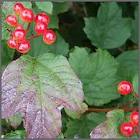ROSE BAY WILLOW HERB, EPILOBIUM ANGUSTIFOLIUM
 Seemingly the plant has now grown much more common all over the UK and Ireland where it is called Lus na tine or in English Blooming Sally, perhaps because it has leaves like the willow tree, of the genus Salix. It has often been remarked that the leaves actually look a little like those of the bay tree too. Some have referred to it as a “bothersome weed” as it spreads easily.
Seemingly the plant has now grown much more common all over the UK and Ireland where it is called Lus na tine or in English Blooming Sally, perhaps because it has leaves like the willow tree, of the genus Salix. It has often been remarked that the leaves actually look a little like those of the bay tree too. Some have referred to it as a “bothersome weed” as it spreads easily. It spreads by seeds which are attached to white hairs which have been used for stuffing, like kapok. These appear in autumn when the seed pod splits into four and ejects the hairs and seeds which are carried on the wind to new blooming places.
It spreads by seeds which are attached to white hairs which have been used for stuffing, like kapok. These appear in autumn when the seed pod splits into four and ejects the hairs and seeds which are carried on the wind to new blooming places. Despite its apparent rarity, Culpeper used it in the 17th century for its antispasmodic properties for asthma and whooping-cough. An infusion of the leaves is used for these purposes. The plant is native to parts of Europe and southern Asia and also grows in North America , although whether it has been introduced or is a native species is open to debate.
 In
In  The leaves can be made into a tisane but have been used as an adulterant in some tea. The root can, like chicory roots, be made into a coffee substitute. It is a member of the Onagrariaceae family of plants, and is also known by the Latin name Chamaenerion angustifolium, although this is sometimes misspelled as Chamerion. The stems look red, and this has given rise to another name for this plant, Blood Vine, although it is an erect plant and certainly not a vine. It can grow to heights of between four and eight feet.
The leaves can be made into a tisane but have been used as an adulterant in some tea. The root can, like chicory roots, be made into a coffee substitute. It is a member of the Onagrariaceae family of plants, and is also known by the Latin name Chamaenerion angustifolium, although this is sometimes misspelled as Chamerion. The stems look red, and this has given rise to another name for this plant, Blood Vine, although it is an erect plant and certainly not a vine. It can grow to heights of between four and eight feet. The French Canadians of the Gaspe Peninsula call the plant ‘wild asparagus’ and eat the young shoots in the same way that you would asparagus. The roots are edible and can be boiled and eaten as you would a Jerusalem artichoke, or added to soups and stews. The leaves can be made into a tisane and these contain vitamins A and C as well as at least one of the B-complex vitamins, riboflavin. They also contain the mineral phosphorous.
 The powdered root has been used to stop internal bleeding, but the plant is mainly used now in tisanes- leaves and roots for diarrhoea, dysentery and stomach cramps, while an extract of the leaves may have anti-inflammatory properties scientists believe. A poultice of the leaves has been used in folk medicine for mouth ulcers and in
The powdered root has been used to stop internal bleeding, but the plant is mainly used now in tisanes- leaves and roots for diarrhoea, dysentery and stomach cramps, while an extract of the leaves may have anti-inflammatory properties scientists believe. A poultice of the leaves has been used in folk medicine for mouth ulcers and in It’s a very attractive plant and it seems to have health benefits too, as well as most of it being edible.















































